31.10.2024
NASA spacecraft to Jupiter’s moon uses UT research to determine if it’s habitable
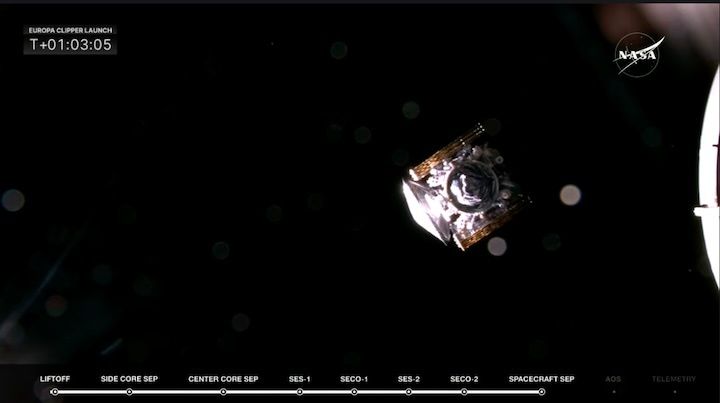
To determine if one of Jupiter’s moons is habitable, NASA launched a spacecraft called the Europa Clipper on Oct. 14, utilizing technology designed in the 1990s by researchers at the Jackson School of Geosciences.
UT researchers initially developed Radar for Europa Assessment and Sounding: Ocean to Near-surface in 1998 to investigate the ice sheets in Antarctica. The radar is one of nine instruments aboard the Europa Clipper. This is the most expensive planetary mission by NASA on record, said lead REASON investigator Don Blankenship.
The instrument will help NASA look for the combination of water, organic compounds and energy that could hint at possible life beneath the barren ice shell. Life needs building blocks such as carbon, sulfur, nitrogen, oxygen and most importantly, time to develop.
“All of those seem very promising for Europa, but one of the reasons that we need to have Europa Clipper is to go and quantify the likelihood for all of those different possibilities and try to assess if Europa is habitable,” said Krista Soderlund, research associate professor in the UT Institute for Geophysics, who joined the project over 10 years ago.
In 1998, astronomers approached Blankenship astronomers about studying ice-covered oceans, resulting in him developing a prototype with the Jet Propulsion Laboratory, where he proposed a small mission to Europa.
However, funding for the mission was not approved when they pitched it to Congress in 1999. Blankenship and his team spent the next 15 years researching Europa and conducting a sequence of five studies every three years. With the help of former U.S. Rep. John Culberson on the House Appropriations Committee, they received the funding for the mission in 2014, and the radar was officially selected to accompany the Europa Clipper for its 2024 launch.
“It’s a $5 billion mission, and our radar was $300 million,” Blankenship said. “So we were a small fraction, but we had to defend our radar in the context of this mission. … The politics of convincing everyone that it’s worth expending those resources are monumental.”
For Soderlund, Blankenship and Natalie Wolfenbarger, a postdoctoral associate at Stanford who worked on REASON, the experience of watching their decade-long work finally launch into space was life changing.
“The underlying terror that something could go wrong as you watch it going further and further up in the sky until you can’t see it anymore — those feelings move from terror to this joy and excitement and anticipation for the next phases,” Wolfenbarger said.
Quelle: The University of Texas at Austin
----
Update: 29.11.2024
.
NASA's Europa Clipper probe deploys 1st science instruments en route to Jupiter
"It's an exciting time on the spacecraft, getting these key deployments done."
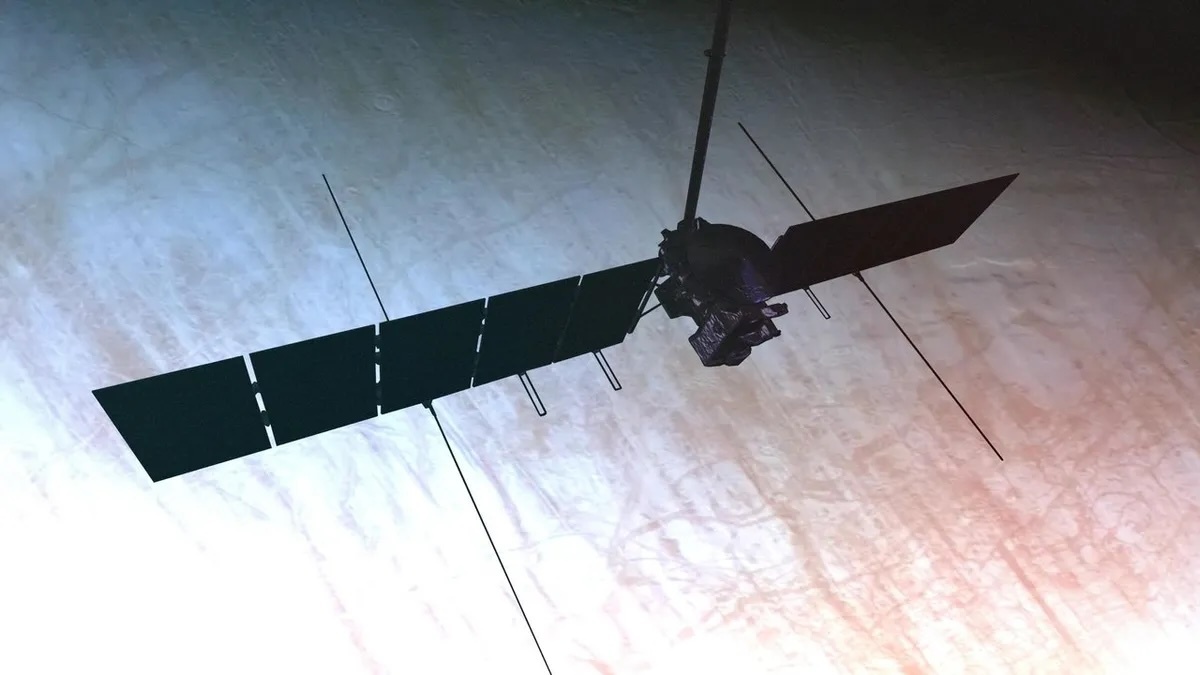
An illustration of the Europa Clipper spacecraft with its solar arrays, magnetometer's boom and several antennas for the radar instrument deployed. (Image credit: NASA/JPL-Caltech)
NASA's Europa Clipper mission has successfully deployed two of its science instruments as it makes its way to the Jupiter system.
Launched on Oct. 14, the Europa Clipper spacecraft is currently en route to study Jupiter's icy moon Europa, which is believed to harbor a subsurface ocean. The mission lifted off from NASA's Kennedy Space Center in Florida atop a SpaceX Falcon Heavy rocket. It has since ventured 13 million miles (20 million kilometers) from Earth, traveling at a speed of 22 miles per second (35 kilometers per second) relative to the sun, according to a statement from NASA.
"Europa Clipper is the largest spacecraft NASA has ever developed for a planetary mission," NASA officials said in the statement. "It will travel 1.8 billion miles (2.9 billion kilometers) to arrive at Jupiter in 2030 and in 2031 will begin a series of 49 flybys, using a suite of instruments to gather data that will tell scientists if the icy moon and its internal ocean have the conditions needed to harbor life."
The spacecraft has so far operated as expected, having deployed its massive solar arrays shortly after launch. The solar arrays, which extend the length of a basketball court, collect sunlight to power the spacecraft on its journey to Jupiter, and during its science work in the Jovian system.
Recently, the magnetometer's boom and several antennas for the spacecraft's radar instrument were deployed and will remain extended from the spacecraft for the full duration of the mission.
Measuring 28 feet (8.5 meters), the boom uncoiled from a canister mounted on the spacecraft body. Sensors paired with the hardware confirmed the deployment was successful. Once the spacecraft reaches Jupiter, the magnetometer will be used to measure the magnetic field around Europa. This will help scientists confirm the existence of the ocean believed to lie beneath the moon's icy crust and measure its depth and salinity, according to the statement.
The radar instrument includes four high-frequency antennas that extend crosswise from the solar arrays, each measuring 57.7 feet (17.6 m) long, and eight rectangular very-high-frequency antennas, each 9 feet (2.76 m) long. Engineering data transmitted back from the spacecraft allows the mission team to assess how the hardware is operating.
"It's an exciting time on the spacecraft, getting these key deployments done," Jordan Evans, Europa Clipper project manager from NASA's Jet Propulsion Laboratory in Southern California, said in the statement. "Most of what the team is focusing on now is understanding the small, interesting things in the data that help them understand the behavior of the spacecraft on a deeper level. That's really good to see."
The team will continue to check the spacecraft's hardware, with seven more instruments expected to power on and off in a series of tests planned for December and January.
To reach Jupiter, Clipper will perform a few gravity assists by looping around Mars and then back around Earth. This maneuver allows the spacecraft to leverage a planet's gravitational pull to gain speed and alter its trajectory.
The first Mars gravity assist is slated for March 1, 2025, when scientists plan to do a few tests of the radar instrument and turn on the spacecraft's thermal imager to capture multicolored images of Mars. The spacecraft will then swing by Earth in December 2026 to propel it further toward Jupiter. The team will use that final gravity assist around Earth to calibrate the magnetometer and measure our planet's magnetic field, according to the statement.
Quelle: SC
----
Update: 3.12.2024
.
Over a month into mission, Europa Clipper continues deploying instruments

On Oct. 14, NASA’s groundbreaking Europa Clipper mission launched from Launch Complex 39A at the Kennedy Space Center in Florida atop a SpaceX Falcon Heavy rocket. Falcon Heavy’s 27 Merlin engines and single vacuum-optimized Merlin engine sent Europa Clipper on a trajectory out of the Earth-Moon system at a speed of approximately 35 km/s relative to the Sun.
Over a month and a half into its mission, Europa Clipper is around 20 million km from Earth. Following its separation from the Falcon Heavy upper stage and initial communications and health checks, teams began working to deploy Europa Clipper’s suite of instruments. Thus far, two instruments have been deployed and will stay deployed throughout the rest of the mission, as well as a number of spacecraft elements needed for operations in space.
While the 20 million km the spacecraft has traveled thus far may seem like quite the journey, by the time Europa Clipper reaches Jupiter, it will have traveled over 2.9 billion km throughout the solar system and have performed two flybys of Mars and Earth. Once at Jupiter, the spacecraft will execute 49 flybys of Europa to characterize and investigate the icy moon in extreme detail, potentially revealing a world that features the conditions needed for life.
However, these critical science observations won’t begin until the spacecraft is at Jupiter. Currently, teams are receiving only engineering data from the spacecraft, which tells them the health of the spacecraft and how its various components are adjusting to space. Thus far, teams have confirmed that everything on the spacecraft is healthy and performing as expected.
The first major spacecraft component to be deployed was Europa Clipper’s massive solar arrays, which, when extended, span the length of a basketball court. The deployment of the solar arrays was a critical moment for the mission’s teams, as the spacecraft could not perform its mission without their power. Fortunately, the arrays fully deployed as expected and are producing power for the spacecraft.
After solar array deployment, the spacecraft’s magnetometer boom deployed. The boom extended from a small canister mounted on the side of the spacecraft bus and uncoiled to 8.5 m away from the spacecraft. Mission teams looked at the data from three sensors on the boom to confirm that it deployed as intended. These three sensors will be used to confirm the presence of a subsurface ocean at Europa and provide scientists with details on its depth, salinity, and other characteristics.
Next was the deployment of several antennas used by the spacecraft’s radar instrument. These four high-frequency antennas extended crosswise from the solar arrays, appearing as two long poles that each measure 17.6 m long. Additionally, eight very-high-frequency rectangular antennas were deployed, each measuring 2.76 m long. Two of these eight very-high-frequency antennas are located on the solar arrays.
“It’s an exciting time on the spacecraft, getting these key deployments done. Most of what the team is focusing on now is understanding the small, interesting things in the data that help them understand the behavior of the spacecraft on a deeper level. That’s really good to see,” said Europa Clipper project manager Jordan Evans of NASA’s Jet Propulsion Laboratory (JPL) in California.
With the magnetometer boom and radar instrument now deployed, seven instruments await deployment/commissioning by mission teams. These instruments will be repeatedly powered on and off throughout the next few weeks so that engineers can confirm their health and performance. Some of these instruments, such as the visible imager and gas and dust mass spectrometer, won’t be fully deployed for the next three years to protect their components from damage from the Sun as Europa Clipper travels through the inner solar system.
Once every instrument and spacecraft system has been checked out and confirmed healthy, teams will begin preparing for Europa Clipper’s first flyby — a flyby of Mars on March 1, 2025. The flyby will serve as a gravity assist maneuver, during which Europa Clipper will use Mars’ gravity to increase its velocity, which, in turn, increases its orbit’s furthest point from the Sun and brings its trajectory closer to Jupiter’s orbit.
In preparation for the flyby, teams have already had the spacecraft perform a single course correction maneuver to ensure Europa Clipper is on the correct trajectory to Mars. Once at Mars, mission scientists will use the flyby as an opportunity to confirm that their instruments are working as expected. Specifically, the thermal imager and radar instrument will be tested during this first flyby.
Europa Clipper’s Mars flyby is the first of two flybys the spacecraft will perform on its way to Jupiter. The spacecraft is set to perform a flyby of Earth in December 2026, during which its magnetometer instrument will measure Earth’s magnetic field.
Quelle: NSF
----
Update: 6.02.2025
.
En Route to Jupiter, NASA’s Europa Clipper Captures Images of Stars
The spacecraft’s star trackers help engineers orient the orbiter throughout its long journey to Jupiter’s icy moon Europa.
![]()
Engineers on NASA’s Europa Clipper mission work with the spacecraft’s star trackers in a clean room at the agency’s Jet Propulsion Laboratory in 2022. Used for orienting the spacecraft, the star trackers are seen here with red covers to protect their lenses.
Credit: NASA/JPL-Caltech


This mosaic of a star field — showing part of the constellation Corvus — was made from three images captured Dec. 4, 2024, by star tracker cameras aboard NASA’s Europa Clipper spacecraft. Use the slider to view the star field with and without star names labeled. Credit: NASA/JPL-Caltech
Three months after its launch from NASA’s Kennedy Space Center in Florida, the agency’s Europa Clipper has another 1.6 billion miles (2.6 billion kilometers) to go before it reaches Jupiter’s orbit in 2030 to take close-up images of the icy moon Europa with science cameras.
Meanwhile, a set of cameras serving a different purpose is snapping photos in the space between Earth and Jupiter. Called star trackers, the two imagers look for stars and use them like a compass to help mission controllers know the exact orientation of the spacecraft — information critical for pointing telecommunications antennas toward Earth and sending data back and forth smoothly.
In early December, the pair of star trackers (formally known as the stellar reference units) captured and transmitted Europa Clipper’s first imagery of space. The picture, composed of three shots, shows tiny pinpricks of light from stars 150 to 300 light-years away. The starfield represents only about 0.1% of the full sky around the spacecraft, but by mapping the stars in just that small slice of sky, the orbiter is able to determine where it is pointed and orient itself correctly.
The starfield includes the four brightest stars — Gienah, Algorab, Kraz, and Alchiba — of the constellation Corvus, which is Latin for “crow,” a bird in Greek mythology that was associated with Apollo.
Hardware Checkout
Besides being interesting to stargazers, the photos signal the successful checkout of the star trackers. The spacecraft checkout phase has been going on since Europa Clipper launched on a SpaceX Falcon Heavy rocket on Oct. 14, 2024.
“The star trackers are engineering hardware and are always taking images, which are processed on board,” said Joanie Noonan of NASA’s Jet Propulsion Laboratory in Southern California, who leads the mission’s guidance, navigation and control operations. “We usually don’t downlink photos from the trackers, but we did in this case because it’s a really good way to make sure the hardware — including the cameras and their lenses — made it safely through launch.”
Pointing the spacecraft correctly is not about navigation, which is a separate operation. But orientation using the star trackers is critical for telecommunications as well as for the science operations of the mission. Engineers need to know where the science instruments are pointed. That includes the sophisticated Europa Imaging System (EIS), which will collect images that will help scientists map and examine the moon’s mysterious fractures, ridges, and valleys. For at least the next three years, EIS has its protective covers closed.
Europa Clipper carries nine science instruments, plus the telecommunications equipment that will be used for a gravity science investigation. During the mission’s 49 flybys of Europa, the suite will gather data that will tell scientists if the icy moon and its internal ocean have the conditions to harbor life.
The spacecraft already is 53 million miles (85 million kilometers) from Earth, zipping along at 17 miles per second (27 kilometers per second) relative to the Sun, and soon will fly by Mars. On March 1, engineers will steer the craft in a loop around the Red Planet, using its gravity to gain speed.
More About Europa Clipper
Europa Clipper’s three main science objectives are to determine the thickness of the moon’s icy shell and its interactions with the ocean below, to investigate its composition, and to characterize its geology. The mission’s detailed exploration of Europa will help scientists better understand the astrobiological potential for habitable worlds beyond our planet.
Managed by Caltech in Pasadena, California, JPL leads the development of the Europa Clipper mission in partnership with the Johns Hopkins Applied Physics Laboratory in Laurel, Maryland, for NASA’s Science Mission Directorate in Washington. APL designed the main spacecraft body in collaboration with JPL and NASA’s Goddard Space Flight Center in Greenbelt, Maryland, NASA’s Marshall Space Flight Center in Huntsville, Alabama, and Langley Research Center in Hampton, Virginia. The Planetary Missions Program Office at Marshall executes program management of the Europa Clipper mission. NASA’s Launch Services Program, based at Kennedy, managed the launch service for the Europa Clipper spacecraft.
Quelle: NASA
----
Update: 27.02.2025
.
NASA’s Europa Clipper Uses Mars to Go the Distance
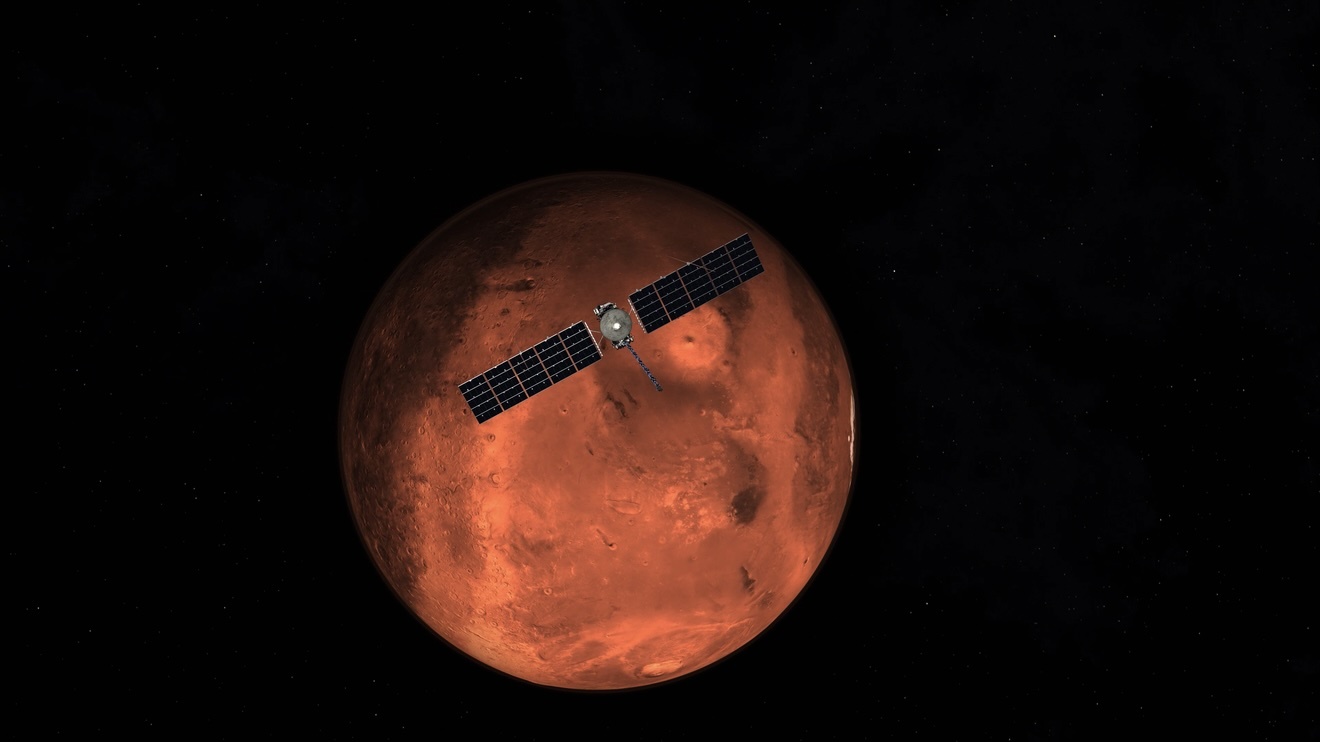
This artist’s concept depicts NASA’s Europa Clipper as it flies by Mars, using the planet’s gravitational force to alter the spacecraft’s path on its way to the Jupiter system.
Credit: NASA/JPL-Caltech
The orbiter bound for Jupiter’s moon Europa will investigate whether the moon is habitable, but it first will get the help of Mars’ gravitational force to get to deep space.
On March 1, NASA’s Europa Clipper will streak just 550 miles (884 kilometers) above the surface of Mars for what’s known as a gravity assist — a maneuver to bend the spacecraft’s trajectory and position it for a critical leg of its long voyage to the Jupiter system. The close flyby offers a bonus opportunity for mission scientists, who will test their radar instrument and thermal imager.
Europa Clipper will be closest to the Red Planet at 12:57 p.m. EST, approaching it at about 15.2 miles per second (24.5 kilometers per second) relative to the Sun. For about 12 hours prior and 12 hours after that time, the spacecraft will use the gravitational pull of Mars to pump the brakes and reshape its orbit around the Sun. As the orbiter leaves Mars behind, it will be traveling at a speed of about 14 miles per second (22.5 kilometers per second).
The flyby sets up Europa Clipper for its second gravity assist — a close encounter with Earth in December 2026 that will act as a slingshot and give the spacecraft a velocity boost. After that, it’s a straightforward trek to the outer solar system; the probe is set to arrive at Jupiter’s orbit in April 2030.
“We come in very fast, and the gravity from Mars acts on the spacecraft to bend its path,” said Brett Smith, a mission systems engineer at NASA’s Jet Propulsion Laboratory in Southern California. “Meanwhile, we’re exchanging a small amount of energy with the planet, so we leave on a path that will bring us back past Earth.”
Harnessing Gravity
Europa Clipper launched from Kennedy Space Center in Florida on Oct. 14, 2024, via a SpaceX Falcon Heavy, embarking on a 1.8-billion-mile (2.9-billion-kilometer) trip to Jupiter, which is five times farther from the Sun than Earth is. Without the assists from Mars in 2025 and from Earth in 2026, the 12,750-pound (6,000-kilogram) spacecraft would require additional propellant, which adds weight and cost, or it would take much longer to get to Jupiter.
Gravity assists are baked into NASA’s mission planning, as engineers figure out early on how to make the most of the momentum in our solar system. Famously, the Voyager 1 and Voyager 2 spacecraft, which launched in 1977, took advantage of a once-in-a-lifetime planetary lineup to fly by the gas giants, harnessing their gravity and capturing data about them.
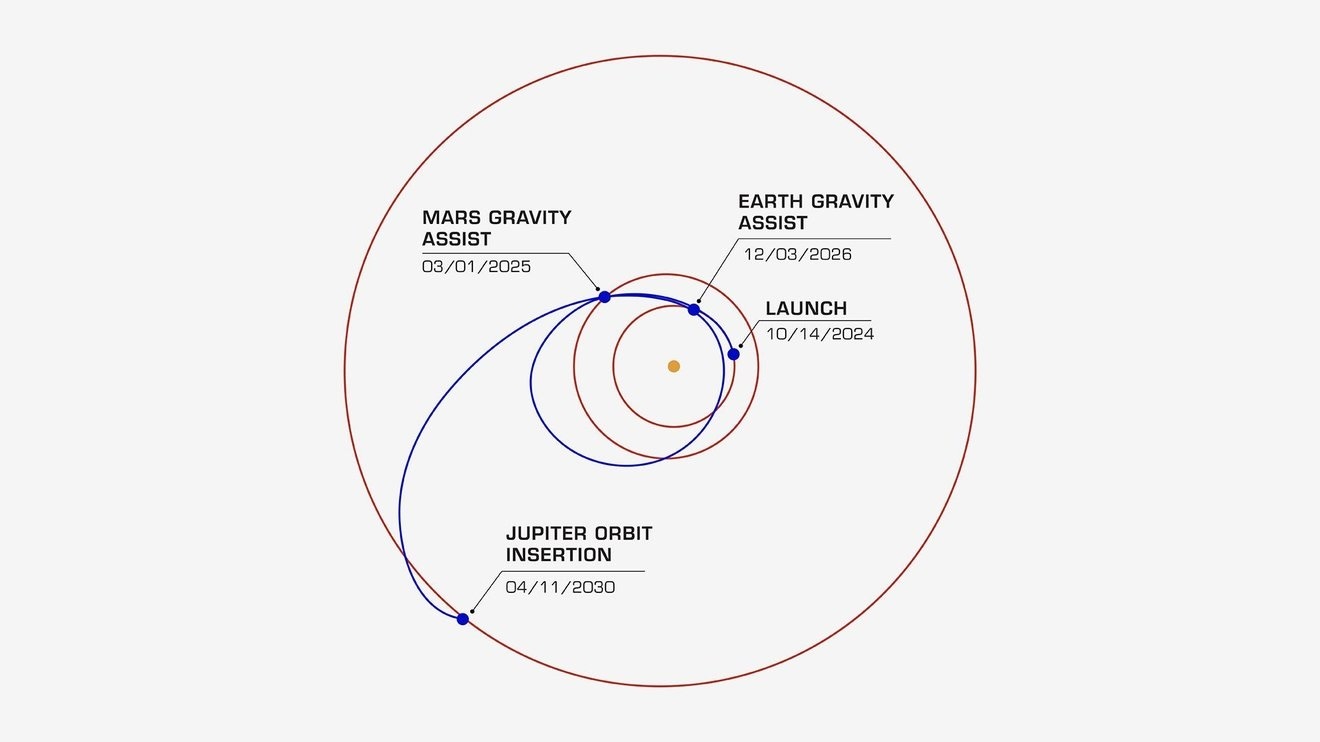
About 4½ months after its launch, NASA’s Europa Clipper is set to perform a gravity assist maneuver as it flies by Mars on March 1. Next year the spacecraft will swing back by Earth for a final gravity assist before heading to Jupiter’s orbit.
Credit: NASA/JPL-Caltech
While navigators at JPL, which manages Europa Clipper and Voyager, have been designing flight paths and using gravity assists for decades, the process of calculating a spacecraft’s trajectory in relation to planets that are constantly on the move is never simple.
“It’s like a game of billiards around the solar system, flying by a couple of planets at just the right angle and timing to build up the energy we need to get to Jupiter and Europa,” said JPL’s Ben Bradley, Europa Clipper mission planner. “Everything has to line up — the geometry of the solar system has to be just right to pull it off.”
Refining the Path
Navigators sent the spacecraft on an initial trajectory that left some buffer around Mars so that if anything were to go wrong in the weeks after launch, Europa Clipper wouldn’t risk impacting the planet. Then the team used the spacecraft’s engines to veer closer to Mars’ orbit in what are called trajectory correction maneuvers, or TCMs.
Mission controllers have performed three TCMs to set the stage for the Mars gravity assist — in early November, late January, and on Feb. 14. They will conduct another TCM about 15 days after the Mars flyby to ensure the spacecraft is on track and are likely to conduct additional ones — upwards of 200 — throughout the mission, which is set to last until 2034.
Opportunity for Science
While navigators are relying on the gravity assist for fuel efficiency and to keep the spacecraft on their planned path, scientists are looking forward to the event to take advantage of the close proximity to the Red Planet and test two of the mission’s science instruments.
About a day prior to the closest approach, the mission will calibrate the thermal imager, resulting in a multicolored image of Mars in the months following as the data is returned and scientists process the data. And near closest approach, they’ll have the radar instrument perform a test of its operations — the first time all its components will be tested together. The radar antennas are so massive, and the wavelengths they produce so long that it wasn’t possible for engineers to test them on Earth before launch.
More About Europa Clipper
Europa Clipper’s three main science objectives are to determine the thickness of the moon’s icy shell and its interactions with the ocean below, to investigate its composition, and to characterize its geology. The mission’s detailed exploration of Europa will help scientists better understand the astrobiological potential for habitable worlds beyond our planet.
Managed by Caltech in Pasadena, California, JPL leads the development of the Europa Clipper mission in partnership with the Johns Hopkins Applied Physics Laboratory in Laurel, Maryland, for NASA’s Science Mission Directorate in Washington. APL designed the main spacecraft body in collaboration with JPL and NASA’s Goddard Space Flight Center in Greenbelt, Maryland, NASA’s Marshall Space Flight Center in Huntsville, Alabama, and Langley Research Center in Hampton, Virginia. The Planetary Missions Program Office at Marshall executes program management of the Europa Clipper mission. NASA’s Launch Services Program, based at Kennedy, managed the launch service for the Europa Clipper spacecraft.
Quelle: NASA
----
Update: 1.04.2025
.
Visiting Mars on the Way to the Outer Solar System
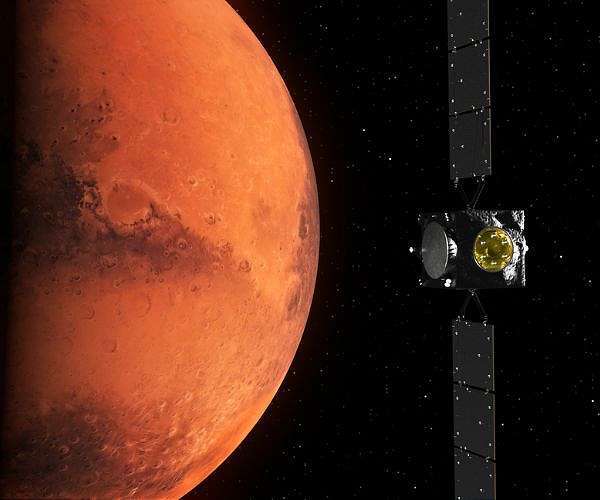
Recently Mars has had a few Earthly visitors. On March 1, NASA's Europa Clipper flew within 550 miles (884 kilometers) of the Red Planet's surface on its way out to Jupiter. On March 12, the European Space Agency's Hera spacecraft flew within about 3,100 miles (5,000 kilometers) of Mars, and only 300 kilometers from its moon, Deimos. Hera is on its way to study the binary asteroid Didymos and its moon Dimorphos. Next year, in May 2026, NASA's Psyche mission is scheduled to buzz the Red Planet on its way to the metal-rich asteroid 16 Psyche, coming within a few thousand kilometers.
Why all these visits to Mars? You might at first think that they're using Mars as an object of opportunity for their cameras, and you would be partially right. But Mars has more to give these missions than that. The main reason for these flybys is the extra speed that Mars' velocity around the Sun can give them. The idea that visiting a planet can speed up a spacecraft is not all that obvious, because the same gravity that attracts the spacecraft on its way towards the planet will exert a backwards force as the spacecraft leaves the planet.
The key is in the direction that it approaches and leaves the planet. If the spacecraft leaves Mars heading in the direction that Mars is traveling around the Sun, it will gain speed in that direction, slingshotting it farther into the outer solar system. A spacecraft can typically gain several percent of its speed by performing such a slingshot flyby. The closer it gets to the planet, the bigger the effect. However, no mission wants to be slowed by the upper atmosphere, so several hundred kilometers is the closest that a mission should go. And the proximity to the planet is also affected by the exact direction the spacecraft needs to go when it leaves Mars.
Clipper's Mars flyby was a slight exception, slowing down the craft - by about 1.2 miles per second (2 kilometers per second) - to steer it toward Earth for a second gravity assist in December 2026. That will push the spacecraft the rest of the way to Jupiter, for its 2030 arrival.
While observing Mars is not the main reason for their visits, many of the visiting spacecraft take the opportunity to use their cameras either to perform calibrations or to study the Red Planet and its moons.
During Clipper's flyby over sols 1431-1432, Mastcam-Z was directed to watch the skies for signs of the interplanetary visitor. Clipper's relatively large solar panels could have reflected enough sunlight for it to be seen in the Mars night sky, much as we can see satellites overhead from Earth. Unfortunately, the spacecraft entered the shadow of Mars just before it came into potential view above the horizon from Perseverance's vantage point, so the sighting did not happen. But it was worth a try.
Meanwhile, back on the ground, Perseverance is performing something of a cliff-hanger. "Sally's Cove" is a relatively steep rock outcrop in the outer portion of Jezero crater's rim just north of "Broom Hill." Perseverance made an approach during March 19-23, and has been exploring some dark-colored rocks along this outcrop, leaving the spherules behind for the moment. Who knows what Perseverance will find next?
Quelle: SD
